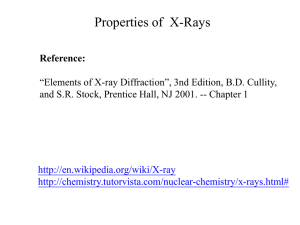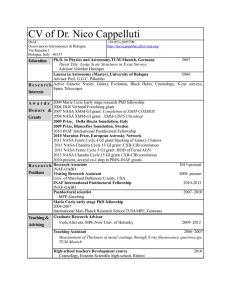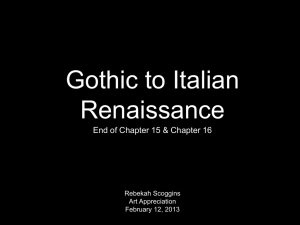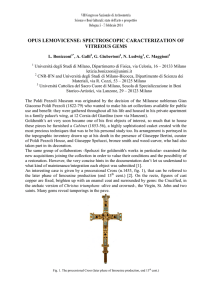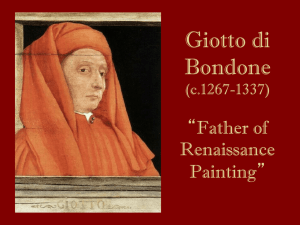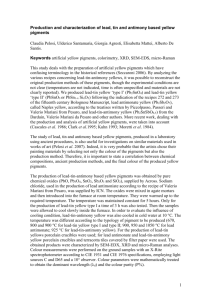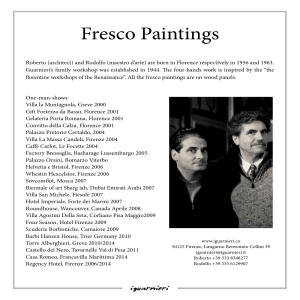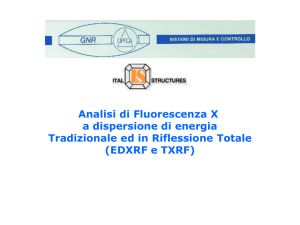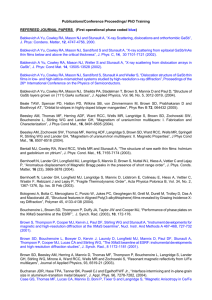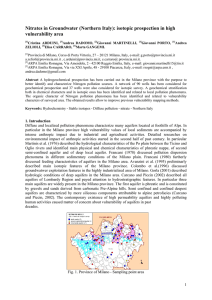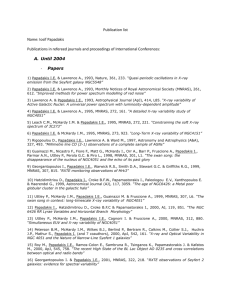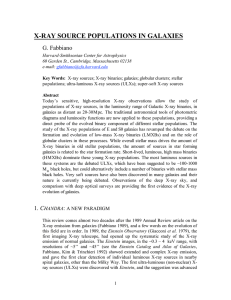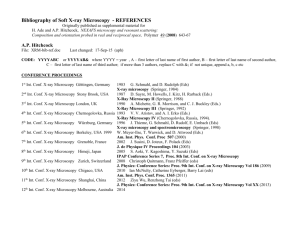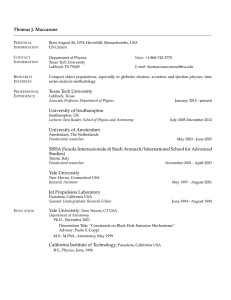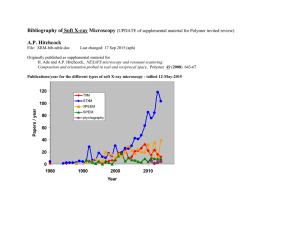Mazzinghi et al, XRF ANALYSES ON THREE MURAL PAINTINGS
advertisement
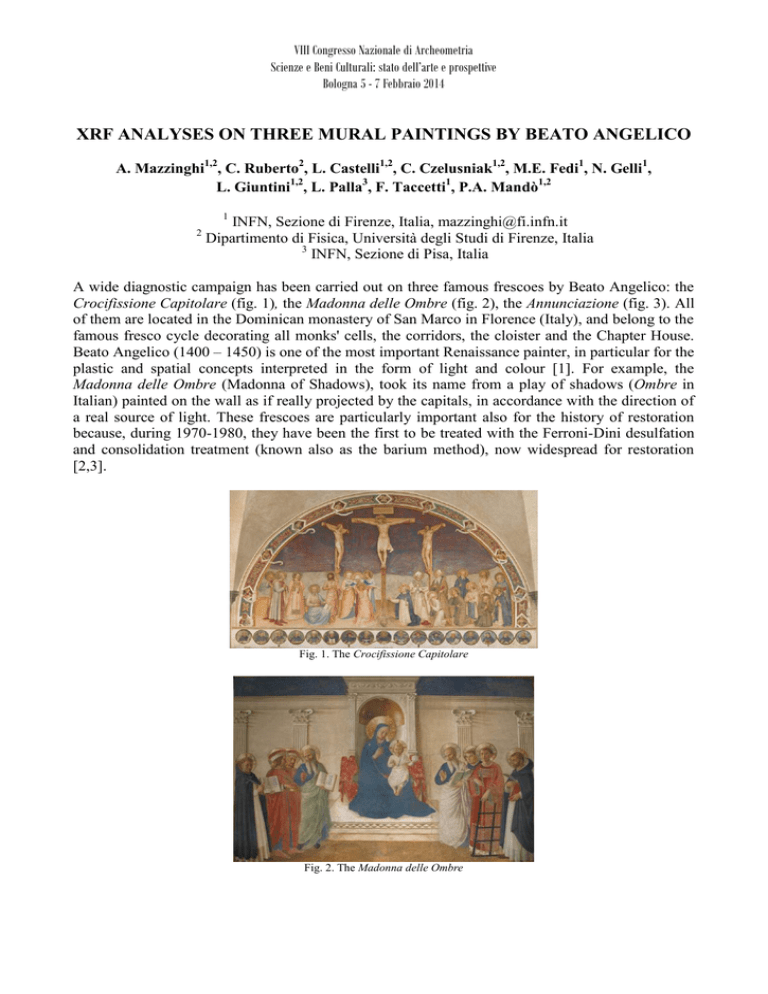
VIII Congresso Nazionale di Archeometria Scienze e Beni Culturali: stato dell’arte e prospettive Bologna 5 - 7 Febbraio 2014 XRF ANALYSES ON THREE MURAL PAINTINGS BY BEATO ANGELICO A. Mazzinghi1,2, C. Ruberto2, L. Castelli1,2, C. Czelusniak1,2, M.E. Fedi1, N. Gelli1, L. Giuntini1,2, L. Palla3, F. Taccetti1, P.A. Mandò1,2 1 2 INFN, Sezione di Firenze, Italia, mazzinghi@fi.infn.it Dipartimento di Fisica, Università degli Studi di Firenze, Italia 3 INFN, Sezione di Pisa, Italia A wide diagnostic campaign has been carried out on three famous frescoes by Beato Angelico: the Crocifissione Capitolare (fig. 1), the Madonna delle Ombre (fig. 2), the Annunciazione (fig. 3). All of them are located in the Dominican monastery of San Marco in Florence (Italy), and belong to the famous fresco cycle decorating all monks' cells, the corridors, the cloister and the Chapter House. Beato Angelico (1400 – 1450) is one of the most important Renaissance painter, in particular for the plastic and spatial concepts interpreted in the form of light and colour [1]. For example, the Madonna delle Ombre (Madonna of Shadows), took its name from a play of shadows (Ombre in Italian) painted on the wall as if really projected by the capitals, in accordance with the direction of a real source of light. These frescoes are particularly important also for the history of restoration because, during 1970-1980, they have been the first to be treated with the Ferroni-Dini desulfation and consolidation treatment (known also as the barium method), now widespread for restoration [2,3]. Fig. 1. The Crocifissione Capitolare Fig. 2. The Madonna delle Ombre VIII Congresso Nazionale di Archeometria Scienze e Beni Culturali: stato dell’arte e prospettive Bologna 5 - 7 Febbraio 2014 Fig. 3. The Annunciazione Beato Angelico was a great fresco painter, and most of his mural paintings are made with the “buon fresco” technique; only the Madonna delle Ombre, among the whole fresco cycle, was made mainly with the secco technique. As it is well known, the difference between these two painting techniques is that the fresco consists in executing the painting on freshly laid lime plaster with the pigment dispersed in water, while in the secco the pigment is tempered in an organic medium (such as egg yolk or whole egg) and applied to the dried plaster. X-Ray Fluorescence (XRF) [4] is one of the most used diagnostic techniques in the field of cultural heritage. Its most important features are the non-destructivity and non-invasivity of the analyses, as they do not imply any damage or sampling of the work of art. Furthermore it allows for quick measurements and for the use of portable instrumentation, thus permitting fast in situ analyses. With XRF studies it is possible to identify and discriminate the materials composing the art object, such as pigments, by revealing the elements present [5]. The measurements have been carried out exploiting the XRF spectrometer developed at the LABEC laboratory (LAboratorio di tecniche nucleari per l’ambiente e i BEni Culturali) of the Istituto Nazionale di Fisica Nucleare (INFN) [6]. Its main peculiar feature is the high efficiency of detection of low-Z elements, maximized by the use of two X-ray tubes with different anode material and a continuous helium flux. The possibility of revealing low-Z elements has been pointed out as crucial feature for discriminating different kind of pigments [7]. In our study we characterized the pigments used by Beato Angelico in the above mentioned paintings, since the two painting techniques (the fresco and the secco) are characterized by different kind of pigments. The conclusions obtained following this approach were reinforced by evaluating the absorption of calcium X-ray lines coming from the plaster. Indeed in general in the secco technique it is typical the use of pigments characterized by high-Z elements, which involves a strong absorption of calcium X-ray lines. In addition, we studied the original gilding technique used by Beato Angelico in the Crocifissione Capitolare and in the Annunciazione, and we also discriminated the original parts from later interventions. In particular, the main goal was to verify, in a non-destructive way, whether the artist used the composite gilding technique (tin-gold foil) and to identify the composition of the preparation layer. As expected, X-Ray Fluorescence (XRF) confirmed to be ideally suited for such a task since it is particularly efficient for medium-high atomic number elements. References [1] Scudieri, M. et al., 1990. Rinvenimenti e restauri del complesso monumentale di San Marco, Alberto Bruschi Ed., Firenze VIII Congresso Nazionale di Archeometria Scienze e Beni Culturali: stato dell’arte e prospettive Bologna 5 - 7 Febbraio 2014 [2] Dini, D. (a cura di), 1996. Gli affreschi del Beato Angelico nel convento di San Marco a Firenze. Rilettura di un capolavoro attraverso un memorabile restauro. Umberto Allemandi & Co. Torino [3] Matteini, M., 1989. In Review: An Assessment of Florentine Methods of Wall Paintings. Conservation Based on the use of Mineral Treatments, in The Conservation of Wall Paintings, Getty Conservation Institute, Londra [4] Van Grieken, R. E., Markowicz, A. A., 2002 - Handbook of X-Ray Spectrometry, Marcel Dekker, Inc. New York [5] Laurie, A.P., 1926. The painter’s method and materials, Seeley, Londra [6] Migliori, A., Bonanni, P., Carraresi, L., Grassi, N., Mandò, P.A., 2011. A novel portable XRF spectrometer with range of detection extended to low-Z elements, X-Ray Spectrom. 40: 107–112 [7] Gettens, R. J., Stout, G. L.,1966. Painting Materials, Dover publications, New York
